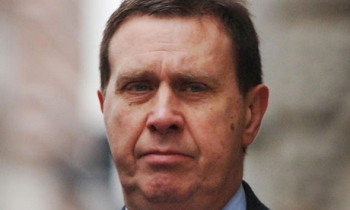As newspaper websites mark their 10th anniversary in Australia this year and online advertising surges, publishers are being forced to take stock of their place in the new media revolution.
Nic Jones, the managing director of News Interactive, says the internet's cannibalising effect on newspaper circulation has been overstated. "I don't think the web is the magpie in the nest that maybe some people do ... It's not as simple as that. The more options people have to do with their time, the more you are going to fragment what they do and how they consume media."
When radio and television appeared, newspapers adopted a "we have to fight them strategy", but the internet was different and could work for newspapers, he said. But they had to be more strategic, to take advantage of the web's heavy traffic at the end of the day to promote the buying of the following day's paper, and to offer more choice in content. "We are still too caught up publishing the same stuff on the web that is in the newspapers."
Mike Game, chief operating officer of Fairfax Digital, joined the group during the dotcom boom, survived the austerity period after the crash and says he's come out the other end "with a rational exuberance".
Game says people are turning to the web for breaking news. This is its great strength, he says, to draw people back during the day for short news grabs and to point to the next day's paper. "In many ways it is displacing more traditional media like radio news services," he says. "But new media has not replaced the core attribute of newspapers, which is the ability to analyse and to provide much deeper insight."
Fairfax is successfully using its online sites, smh.com.au and theage.com.au, to build subscriptions to its newspapers, The Sydney Morning Herald and Melbourne's The Age.
The Age was the first Australian newspaper to have a website, which turned 10 in January, with the SMH site marking its 10th birthday this week. News Limited followed with its first site, newsclassifieds.com.au, and The Australian Online, which later evolved into news.com.au.
Rupert Murdoch, the chairman and chief executive of News Corporation (owner of The Australian), warned in a speech to American editors earlier this month that the digital revolution was not about to limp away and newspapers had to grasp the fast-developing reality of the web.
If there were any doubts about the impact of digital media, figures last week from the Australian Broadcasting Authority confirm its reach: 37 per cent of 8-to-13-year-olds go online daily. Most significantly, the latest information on broadband (high-speed data service) penetration indicates it has passed the half-way mark. More people are now accessing the internet at home through broadband than through dial-up, according to Jones.
Some other indicators of this impact are the jump in online advertising - ad dollars on the web grew four times faster than the average across the main media in Australia last year; and the 50 per cent jump in the past year in membership of the Australian Interactive Media Industry Association, which spans the interactive media and digital content sectors.
On the policy front, a plan for building a robust digital content industry is expected to be put to federal cabinet in the next few months.
The internet has permitted new entrants into areas that have been the preserve of the large media companies. You now have fleet-footed internet players operating in areas such as employment classified advertising (seek.com.au); real estate (realestate.com.au); and search engine Google, for instance, has a news service. What is happening is that the big media players have been forced to respond, either by setting up online competitors to these businesses or by acquiring them, as News did with realestate.com.au.
For newspapers, the key is to offer content on all platforms: mobile phones, the internet and print. And "you have to care about each one equally", says Jones, who has carriage of news.com.au and News's masthead websites. "We are a content manufacturer. We're not a newspaper company, not a TV company, we are a media company ... All we are talking about here is the way we distribute our product," he says. "I see what we are doing online as just as important to the future of newspapers as anything that is happening in the newspapers."
Both Game and Jones, who was previously managing director and sales director of Yahoo, say the internet poses more of a threat to TV. Once video becomes the natural platform for the web, the importance of the internet will take off, says Jones. The days of the internet being the domain of the PC are almost over. He says that perhaps in a little over five years' time, we will be accessing the internet and watching broadband on our TV sets. "That's what's going to make the next explosion happen ... the TV will ultimately be the box that provides everything."
Game says Fairfax's online sites are drawing in a new, younger audience and extending the readership of its newspapers. About one-third of the SMH's online audience comes from Sydney, one-third from elsewhere in NSW and a third from overseas. "So clearly two-thirds are outside the core readership of the SMH, which is very Sydney-centric," he says.
Forty per cent of smh.com.au's audience is aged between 25 and 39, compared with 26 per cent who read The Sydney Morning Herald, and there is a similar picture for The Age. Just over 44 per cent of News Interactive's audience is estimated to be in the 18-39 demographic.
For publishers, multi-platform delivery is no longer an option but mandatory, says Game. The Athens Olympics was the first significant pilot for Fairfax Digital, when it published text, pictures, audio and video and provided content to multiple platforms including third-party sites such as Yahoo and to mobiles.
Game says that five years ago the hype surrounding the internet exceeded what consumers and advertisers wanted. Over the next two to three years he expects "fast-paced incremental change".
Higher rates of broadband will allow news outlets to play to the strength of the media, with more audio and video, but text news reports and pictures will remain most important. This is because people want to consume their internet news similarly to radio news, in short grabs. "What we can do is extend the richness ... but it won't be about downloading and watching video clips."
As the broadband penetration rate into homes increases, he expects people to get more of their news digitally.
The speed of broadband services, which is slower than in many other countries, is a key issue for the Australian Interactive Media Industry Association. Although adequate for the content now available, it isn't fast enough for the next generation of high-speed services including video-on-demand, says chief executive John Butterworth.
"We'd like to see the broadband network treated like other national infrastructure, much in the same way as roads are, and that's the way othercountries have approached it," he says.
The association would also like to see the federal Government adopt the same attitude as the European parliament. In January it decided to invest $248 million to develop digital content across the EU during the next three years, with a focus on expanding beyond national markets.
One of the big challenges is simply coping with the rapid growth. Online ad revenue jumped 64 per cent last year, to $388 million, and content innovations are occurring all the time, giving rise to new regulatory issues. The announcement in recent weeks of three new soap operas for video-enabled mobile phones demonstrates how digital media is moving into new areas.
This creates the need to understand consumer behaviour better, particularly the way people access content in a fragmented media environment. A car maker such as Toyota, for example, once would have had a TV ad at 8.30pm to coincide with the Sunday night movie and would have been sure of reaching an entire family. Now, though, it had to consider how to reach a household where family members might be using different media at the same time, whether SMS texting, emailing, watching TV or using theinternet.
Says Jones: "It is very exciting to think about what the media might look like in 10 to 20 years' time."
He remembers how people scoffed at Bill Gates's prediction in the early 1980s that eventually there would be a personal computer on every desk and in every home. "Everybody laughed ... then a few years later you wake up one day and go 'Look, it's happened.' The internet is a bit like that."









